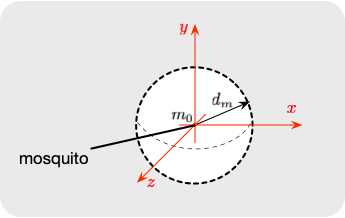Computing the Probability of Catching a Mosquito by Hands
You are resting in bed trying to fall asleep.. and suddenly a mosquito comes into play - what is the chance that you are going to catch it with your hands? Let's try to answer this question by modeling this situation.
The involved variables are:
- the velocity of the mosquito $v_m$,
- the velocity of the arm $v_a$,
- the length of your arm $l_a$,
- the distance between your ear and its relative shoulder $d_{es}$.
In this scenario, we assume that the mosquito is exactly in the position of the ear $e.$
When you decide to move the arm in order to catch the mosquito, instantaneously, the mosquito starts to fly away. In this setting, after an interval of $\nabla t$ seconds, the mosquito is close to the ear in the half-sphere of radius $d_m$.
Considering the max speed of the mosquito $v_m$ traveled in a straight line, the radius of the half-sphere $H\text{-}S$ can be computed as follows:
$$d_m = v_m \cdot \nabla t \ [m]$$
where the interval $\nabla t$ is the amount of time required for the arm to reach the ear (assuming a linear trajectory of the hand):
$$\nabla t = \frac{d_{es} + l_a}{v_a} \ [s].$$
Assuming a uniform spatial distribution of the mosquito in the sphere region, the probability $P_{catch}$ of catching it in a region ball of radius $h$ (this region coincides with your closed hand once you try to catch the mosquito) is:
$$
\begin{split}
P_{catch} &= \int_{H\text{-}S(h)} \frac{1}{Volume(H\text{-}S)} \cdot dx dy dz \\
&= \int_0^h \int_0^\pi \int_0^\pi \frac{2}{\frac{4}{3}\pi d_m^3} r^2 sin\phi \ d\theta \ d\phi \ dr \\
&= \left( \frac{v_a}{v_m} \frac{h}{d_{es} + l_a} \right)^3
\end{split}$$
Now it's time to get some numbers. Searching online I found that:
- the velocity of an average mosquito is $v_m = 0.56 \pm 0.1 \left[ \frac{m}{s} \right]$,
- [1] the velocity of a young man arm is $v_a = 2.5 \left[ \frac{m}{s} \right]$,
- the average length of an arm is $l_a = 0.6 \ [m]$
- the distance between the ear and the shoulder is $d_{es} = 0.2 \ [m]$,
- the radius of a closed hand is $h = 0.04 \ [m]$.
Using such number values we get that the probability of catching the mosquito in your ear is:
$$
P_{catch} = \left( \frac{2.5}{0.56} \frac{0.04}{0.6 + 0.2} \right)^3 \approx 1.11\%$$
$\Rightarrow$ The mosquito will probably fly away :)
References
[1] - Kurt M. DeGoede, James A. Ashton-Miller, Jimmy M. Liao, Neil B. Alexander, How Quickly Can Healthy Adults Move Their Hands to Intercept an Approaching Object? Age and Gender Effects, _The Journals of Gerontology: Series A_, Volume 56, Issue 9, 1 September 2001, Pages M584–M588, [link]


